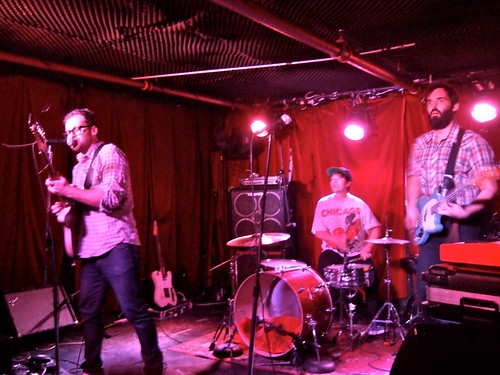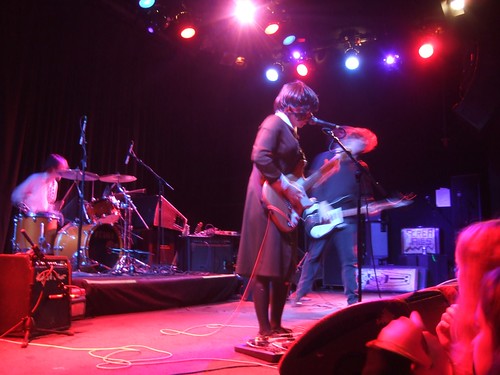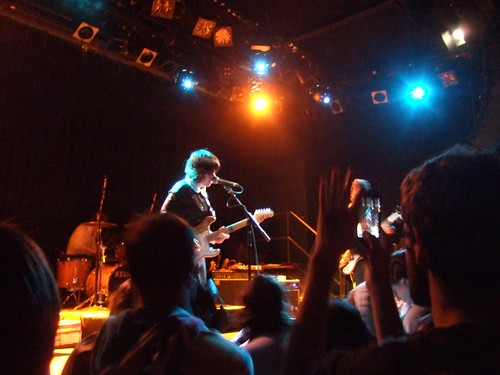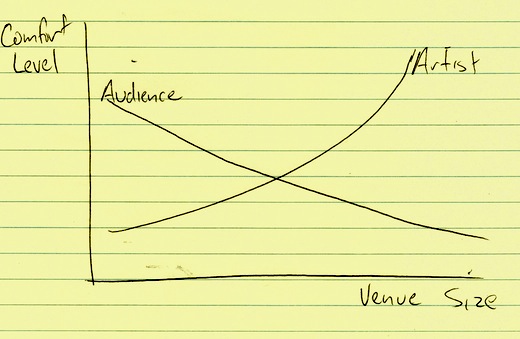This is now an annual tradition! For the second year in a row, we’re going to look through the big list of bands coming into town this week for the CMJ Music Marathon and see if we can divine any trends in band naming.
Numbers
Two is by far the most popular number referenced in band naming. 1, 3, 5, 7, 8, 12, 28, 69, 70 and 1,000,000 are also represented among this crop of names:
- Jupiter One
- Once
- 2am Club
- Mystery of Two
- Twin Atlantic
- Twin Berlin
- Two Fresh
- Two Tears
- Mother Of Three
- Mighty Five
- School of Seven Bells
- The Middle Eight
- 12th Planet
- 28 North
- 69 Eyes
- Expo 70
- A Million Years
Other Quantities
Some quantities aren’t expressible in discrete numbers
- So Many Dynamos
- So Many Wizards
- Super Extra Bonus Party
Speed
Surprisingly, fast and slow are equally represented
- The Fast Romantics
- Slow Country
- Tempo No Tempo
Directions
Go west, young man! All four of the compass directions are represented, but west is the most prevalent.
- 28 North
- Far East Movement
- Mark Knight and Dirty South Live
- Smith Westerns
- Western Civ
- The Western States Motel
Geography
Planets and Satellites
- 12th Planet
- Hooray For Earth
- Man on Earth
- Jupiter One
- Moonbabies
- Moondoggies
- Under The Sherry Moon
- We Landed On The Moon!
- We Are The World
Continents
Oceans
- Pacific Theater
- Twin Atlantic
Countries
- The Brazil Show
- Casino versus Japan
- Electro Morocco & Dreams in Static
- Japandroids
- Japanther
- Look Mexico
- The Maldives
- Portugal. The Man
- French Miami
- Spanish Prisoners
- These United States
- Volcanoless In Canada
States
- Arizona
- The Gulf Of Michigan
Cities
- Appomattox
- Brighton MA
- Capital City
- David Dallas
- French Miami
- Invade Rome
- My Jerusalem
- NYCSmoke
- River Phoenix
- Twin Berlin
Neighborhoods
- Bel Air
- Diamond District
- Harlem
- Robbers on High Street
- The Bowery Riots
Geographical Features
- Beach Fossils
- Best Coast
- Black Bay
- The Frontier Brothers
- The Frontier Ruckus
- The Gulf Of Michigan
- River Phoenix
- Spiral Beach
- Valley of the Shadow of Death
- Vertical Horizon
Buildings
- The Emergency Room
- Home and Garden
- The Library
- Uninhabitable Mansions
Time
- 2am Club
- A Million Years
- All The Day Holiday
- Black & White Years
- Love In October
- The Minutes
- Overnight
- The Past Times
Seasons
- Eternal Summers
- Winterpills
Deoartment of Redundancy Department
Bands so nice they named them twice:
- Bang Bang Eche
- Beep Beep
- Blip Blip Bleep
- Champagne Champagne
- Die! Die! Die!
- Dum Dum Girls
- Fra Fra Sound
- Future Future
- Kill Kill Kill
- Motel Motel
- Runner Runner
- Santino Santino
- The Seedy Seeds
- Shout Out Out Out Out
- Still Life Still
- Takka Takka
- Tall Tall Trees
- Tempo No Tempo
- Tiger! Shit! Tiger! Tiger!
- Veil Veil Vanish
- Voices Voices
- You Scream I Scream
- You, You’re Awesome
Transportation
Air
- Aeroplane
- Aeroplane Pageant
- Denney and the Jets
- Flying Machines
- Hospital Bombers
- In-Flight Safety
- Jets Overhead
- Paper Airplane
- Still Flyin
Land
- Army Navy
- Bridges and Powerlines
- Brit and the Cavalry
- Broadfield Marchers
- Delorean
- The Motorcycle Industry
- BLACK TAXI
- Unicycle Loves You
Sea
- Army Navy
- Floating Action
- Sugar Plum Ferry
Space
- Spaceships are Cool
- We Landed On The Moon!
High vs. Low
- The High Dials
- The High Strung
- Higher Giant
- Highlife
- The Hi-Risers
- Robbers on High Street
- Skyzoo
- Jets Overhead
- Low Frequency In Stereo
Stereo/Mono
Stereo is exactly twice as popular as mono!
- Stereo Skyline
- Low Frequency In Stereo
- Monogold
Color
Black is again the most popular color represented, followed by gold.
- Black & White Years
- Black Anvil
- Black Cherry
- Black Diamond Bay
- Black Holes
- The Black Hollies
- Black Swan Green
- BLACK TAXI
- Black Tie Party
- the black watch
- Black Whales
- Cruel Black Dove
- Dan Black
- Red Wire Black Wire
- Small Black
- Soft Black
- Gold Streets
- The Golden Filter
- Golden Silvers
- Golden Triangle
- Goldhawk
- Solid Gold
- Sugar & Gold
- Monogold
- Hi Red Center
- Red Collar
- Red/X
- Red Wire Black Wire
- Bobby Brown
- Bosque Brown
- White Tie Affair
- Black & White Years
- Blondes
- Blood Orange
- Blue Scholars
- The Bronzed Chorus
- Greycoats
- Pink Noise
- The YellowDogs
Light vs. Dark
Light is slightly more popular than dark and shadow.
- Headlights
- Lightning Love
- The Lights Out
- Lights Resolve
- Dark Meat
- Dark Room Notes
- Valley of the Shadow of Death
Animals
Bears, birds, whales and dinosaurs, oh my!
Bears
- Angry Vs. The Bear
- Bear Hands
- Bear In Heaven
- Care Bears on Fire
- Mama Bear
Birds
- Common Loon
- Cruel Black Dove
- Black Swan Green
- An Albatross
- Fearsome Sparrow
- Hawk and Dove
- Heavy Birds
- Rainbird
- Slang Chickens
- Terror Pigeon Dance Revolt
Whales
- Black Whales
- Freelance Whales
- Vulture Whale
Cats
- The Jaguar Club
- Japanther
- Kittens Ablaze
- Tiger! Shit! Tiger! Tiger!
- Spring Tigers
- Tigercity
Wolves
- Julia Wolfe
- We Are Wolves
- Whistling Wolves
Other Dogs
- Coyote Eyes
- Pitbull
- Moondoggies
- The YellowDogs
Dinosaurs
- Claymation Velociraptor
- Dinosaur Feathers
Insects
- Beehive
- Annie And the Beekeepers
- Deer Tick
Chimeras
- Dinowalrus
- Dragon Turtle
All Others
- The Antlers
- Batrider
- Cobra Skulls
- Crystal Antlers
- Fox Jaws
- Goat Whore
- Kate Bradley & Goodbye Horses
- Mussels
- Pig Destroyer
- Skibunny
- The Telepathic Butterflies
- We Are Country Mice
- Wild Yaks
Food & Drink
- Bamboo Shoots
- The Beautiful Taste
- Black Cherry
- Blood
- Coconuts
- Cookie Martini
- Dark Meat
- Drink Up Buttercup
- Hank & Cupcakes
- Heavy Cream
- Hungry Hands
- Hungry Hungry Ghost
- Lemonade
- Mussels
- Pomegranates
- Sugar & Gold
- Sugar Plum Ferry
Weight
- Fat Tony
- Fatkid Dodgeball
- Heavy Birds
- Heavy Cream
- Heavy Trash
New vs. Old
New and modern are much more popular than old, vintage, classic or historic.
- Awesome New Republic
- Future Future
- Miracles of Modern Science
- Modern Science
- Modern Skirts
- The New Collisions
- The New Loud
- New Villager
- The Past Times
- Old Canes
- Linc with Old Soul
Government and International Relations
Republic is by far the most favored form of government and the Senate is the preferred representative body by this year’s crop of bands. Surprisingly, no fans of direct democracy in the bunch.
- Awesome New Republic
- Great Republic of Rough and Ready
- Senator
- The Senate
- French Horn Rebellion
- International Espionage!
- Invade Rome
- The Surrender
- Terror Pigeon Dance Revolt
Blood
A surprising number of bands are either vampires or decided to use blood in their band names for some other reason.
- Blood Orange
- Blood Warrior
- Bloodgroup
- The Bloodsugars
- Surfer Blood
- Type O Negative
Gender
Male
- Best Man
- The Boy Bathing
- The Brothers Frank
- Brother Joscephus & the Love Revival Revolution Orchestra
- Dead Men Dreaming
- Frat Dad
- The Frontier Brothers
- Gentleman Auction House
- Holy Sons
- The Lives of Famous Men
- Madison Ave Boys
- Male Bonding
- Man Like Me
- Man on Earth
- Natureboy
- octoberman
- Papa
- The Protomen
- The Queen Killing Kings
Female
- Bodega Girls
- Kleenex Girl Wonder
- Little Girls
- Mama Bear
- Metermaids
- Mother Of Three
- Priestess
- Screaming Females
- Sister Hazel
- Sister Sparrow and The Dirty Birds
Young vs. Old
- Chris Young The Rapper
- Choir of Young Believers
- Grandchildren
- Bodega Girls
- Holy Sons
- Kleenex Girl Wonder
- Little Girls
- Moonbabies
- My Teenage Stride
- Natural Child
- Teenage Bottlerocket
- The Teenage Prayers
- Young Boys
- Young Prisms
- Youth Group
- Baby Monster
- Kid Color
- Kid Theodore
- Kidz In Space
- Kidz In The Hall
- Jim McTurnan and The Kids that Killed The Band
- Mother Of Three
- Dead Men Dreaming
- Frat Dad
- The Neanderthals
- Old Canes
Instruments
Does French Horn Rebellion have a french horn player in the band?
- The Bongos
- Cymbals Eat Guitars
- Erin and Her Cello
- French Horn Rebellion
Sports
- Boogie Boarder
- Fatkid Dodgeball
- Hockey
- Let’s Wrestle
- Surf City
- Surfer Blood
- Swimclub
- The Swimmers
- Tennis Pro
- Unicycle Loves You
Teams vs. Bands
Surprisingly, this roster features slightly more bands that are teams than there are bands that are bands.
- Team Facelift
- Team Genius
- Team Robespierre
- Team William
- Math the Band
- Menahan Street Band
- Mia Riddle & Her Band
Body Parts
- The Idle Hands
- Hungry Hands
- Hammer No More The Fingers
- The Naked Hearts
- No Eye Contact
- Shaky Hands
- The Unsacred Hearts
Temperature
Hot is more popular than cold.
- Cold Cave
- Cold Flamez
- Hot Lava
- Hot Panda
- HotChaCha
- Spit Hot Fire
Life and Death
- Dead Heart Bloom
- Dead Leaf Echo
- Dead Men Dreaming
- Dead Sexy Inc.
- Dead Stars
- Deadbeat Darling
- Die! Die! Die!
- Diehard
- Kill Kill Kill
- Kill Krinkle Club
- Ringo Deathstarr
- Valley of the Shadow of Death
- We Should Be Dead
- Highlife
- Still Life Still
- Mammoth Life
- Jonny Lives!
- The Lives of Famous Men
Sex, Drugs and Rock & Roll
- Drug Rug
- drugdealer
- Drunken Barn Dance
- Dirty Sexy Soca
- Dead Sexy Inc.
Love
- Enemy Lovers
- The Fast Romantics
- Unicycle Loves You
- Love Heist
- Love In October
- The Love Language
- LoveLikeFire
- The Lovely Feathers
- Lovemakers
Volume
Not surprisingly, loud is more popular.
- The New Loud
- Quiet Loudly
Shapes
- The Elusive Parallelograms
- Goes Cube
- Golden Triangle
- The Octagon
Rank/Title
- Filthy Dukes
- General Fiasco
- I Was A King
- Jess King
- King Chango
- The King Left
- Sgt Dunbar and the Hobo Banned
The Four Elements
- Man on Earth
- Air Waves
- The Fire & Reason
- Fire Ex
- Care Bears on Fire
- Kittens Ablaze
- Last Tide
- LoveLikeFire
- Quest For Fire
- Spit Hot Fire
- Sure Fire
- Rain Machine
- Rainbird
- The Sea
Size
Big and small are tied at 5 apiece.
- Giant Cloud
- Gigantic Hand
- Nomadic Massive
- Big Sean
- The Big Takeover
- Little Fish
- Little Girls
- Little Teeth
- Small Black
- Beautiful Small Machines
Complete sentences
- We Are Country Mice
- We Are Enfant Terrible
- We Are The World
- We Are Wolves
- We Have Band
- We Landed On The Moon!
- We Should Be Dead
- Jonny Lives!
- We’re Pregnant
- The Whore Moans
Exclamation points!
- Die! Die! Die!
- Gunfight!
- International Espionage!
- Jonny Lives!
- We Landed On The Moon!
- pow wow!
- Tiger! Shit! Tiger! Tiger!
- Zo! & The Els
Other Snazzy Names
These are some names that I couldn’t build a cateogry around, but are entertaining nonetheless:
- Meeting of Important People
- Phil & The Osophers
- Shilpa Ray and Her Happy Hookers
Names in bold are bands we can definitely recommend seeing. Band names in italics are bands we would consider seeing just because their names are awesomely clever or ridiculous.
See also Ear Farm’s CMJ preview, which provides recommendations and information about silly little details like time and location.









